This website has been archived from TrainWeb.org/gyra to TrainWeb.US/gyra.
This website has been archived from TrainWeb.org/gyra to TrainWeb.US/gyra.
Patents relating to Strobes:
US Pat. 3,723,725
[BEACON SIGNALING DEVICES] addresses the reduction of the light intensity in
using colored domes. A scheme for the incorporation of transparent apertures
into the dome is promoted to enhance brightness. Width and spacing of
transparent apertures (circumferential rings around dome) are used to maximize
brightness without destroying color identification.
US Pat. 3,731,082
[EMERGENCY WARNING LIGHT] discusses dome construction (Fresnel lens) used to
direct light rays from the light source into transverse planes. A reflector
mounted the dome directs light output, which would escape out the top, towards
the sides to further enhance light rays to emanate in the transverse direction.
US Pat. 4,213,115 [VISUAL WARNING SIGNAL FOR
A LOCOMOTIVE] discusses the strategic placement of strobes on locomotives, use
of phosphorescent paint on interior of dome to prolong the flash effect
(enhancement to persistence of vision). It also describes triggering and
selection of the strobe in coordination with the sounding of the horn and
headlight switch
Strobes
could be mounted on the forward end or the roof of the locomotive. The forward
end strobes were directional whereas the roof mounted units had 360° coverage.
Star Headlight
& Lantern Co., Inc. 1989 catalog - 3920 Strobe:
The
model 3920 is shown as a flush mounted, FRA & Amtrak approved unit.
"Brilliant Oval Head Marker Lite" / lens colours red or amber @ 72
volts. I think the only units to get them were Amtrak's GE's.
Timothy Organ
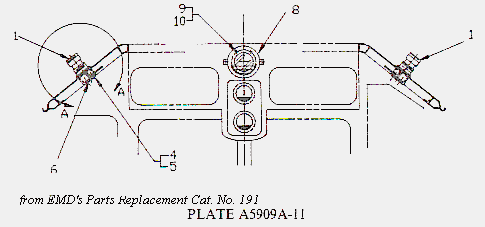
The
original KCS SD50s had three lights between the numberboards. The top was a
strobe. Below was the standard dual beam headlight. On both sides of the cab
roof were additional strobes. All three strobes were controlled by the same
controller giving a very effective warning to people.
Bill Kaufman
The
following information copied off Whelen's literature for a device that was
marketed with a similar setup:
"The
Model 2700RR consists of a pair of alternate firing 360° strobe lights
producing 1100 effective candlepower, flashing 120 flashes per minute combined.
A three level light intensity control is available. This system provides total
visibility of the front end of the train in all angles of approach to a grade
crossing, or while working in a rail yard for the protection of the personnel.
A second option is available which includes a very high intensity, 4000
effective candlepower red strobe light, directional to the front of the engine.
This light can be keyed into the brake system, and has an emergency
override."
In the
Whelen literature on the above system, the red strobe light consisted of a
flashtube housed in a Trans-Lite C-1785 fixture with a red glass
"lens". All of the strobes were listed as having a flash rate of 60
per minute. The supply voltage listed for this setup was 64-80 VDC. The effective
candela readings for the strobes were: 400 High/40 Low - for each of the 360°
strobes and 4000 High/400 Low - for the Red Emergency strobe
The
following photos by Bill Kaufman illustrate the inside of one of these
strobes which are found on some Amtrak F40PH locomotives:
photo 1
photo 2
photo 3
photo 4
photo 5
photo 6
photo 7
As for the strobe light, here is the exact quote for
the F40PH
Specifications for Amtrak units 329 - 360:
"Alerting Light System:
Whelan Engineering Co. alerting light system consisting of twin
white-lensed Xenon flash tubes, a single ren-lensed Xenon flash tube, and solid
state flasher and power supply for 74V DC input."
It does not specifically say who built the red strobe,
but at least we know
the complete system was assembled by Whelan.
Bill Kaufman
Amtrak strobes:
The P32BWH's were delivered with built-in strobes. These are being (or have
been) removed. They were located in the upper corners of the cabs. Two whites
on the outsides, and a red in the center.
Bill Kaufman
Burlington
Northern mounted 2 strobes on the walkway like ditch or crossing lights. These
strobes had box-like housings - each with a circular opening from which the
light signal emanated.
BN
No. 8148 with deck mounted Q2000 strobes (Q2004 package) photo by: Dave Krumenacker

The
strobes were made by Quantum Engineering, Inc. and their part number: Q2000
(Q2004 for the whole kit).
The Q2000 strobes were standalone units.
Q2004 "kit" simply got you two Q2000s and a push button to mount on
the control stand to turn them on. Flash rate was approximately once per
second. As this was not a exact rate, the two strobes would rarely be in
sequence and often appeared to alternate. Effective candela power was in the
200-400 range, way below what is required for ditch light strobes and why BNSF
was quick to replace them.
The operation of the strobes was commonly
hooked into the horn operation, usually with the use of a pressure switch
installed in the horn line. They pretty much always had the manual switch
mounted on the control stand too. Once activated the strobe would flash 32
times before quitting. The effective candela was far below what the FRA now
requires.
Bruce Backus - Quantum Engineering, Inc.
QUANTUM ENGINEERING, INC
352 Stowe Ave.
Orange Park FL 32073
phone: (904) 278-2500
fax: (904) 278-2600
Sec. 229.133 Interim locomotive conspicuity
measures--auxiliary external lights (Strobe lights):
(i) Strobe lights
shall consist of two white stroboscopic lights, each with ``effective
intensity,'' as defined by the Illuminating Engineering Society's Guide for
Calculating the Effective Intensity of Flashing Signal Lights (November 1964),
of at least 500 candela.
(ii) The flash rate of strobe lights shall be at least 40 flashes per minute
and at most 180 flashes per minute.
(iii) Strobe lights shall be placed at the front of the locomotive, at least 48
inches apart, and at least 36 inches above the top of the rail.
These
were the requirements for using strobes in the interim between equipment in use
and the new ruling on conspicuity requiring the triangular pattern of the
sealed beam headlight with 2 other equivalent output sealed beams at the base
(see Ditch-Crossing Lights chapter). It is permissible to have any other
lighting on the locomotive that does not interfere with the mandated triangular
pattern. A strobe with any candela or flash rate can be used. In this chapter
are instructions furnished from Tomar Electronics (catalog No. 99) for finding
the effective candela of a strobe using other parameters. This information will
aid in realization of the relationships needed to bring about a desired
effective candela value.
Amtrak as well as Metra, and
Tri-Rail use the Star Headlight 200BC 360° strobe.

Metra F40PH No. 100 with roof mounted Star Headlight
200BC Strobe and vertical 20585 Gyralite (red lens on bottom)
photo by: Sean Gash
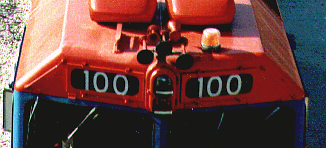
"crop" of above photo

Metra F40C No. 604 with roof mounted strobe? and vertical 20585 Gyralite (red
lens on bottom)
photo by: Sean Gash
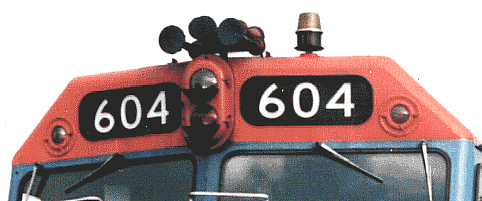
"crop" of above photo
The Metra locomotives above use the Nathan
Model P1235R4A horn.
The strobe on Metra 604:
Seeing as that's
Metra F40C #604, which still runs in regular service on Metra's Milwaukee District
lines, it would be the same as those on B-B F40PH-2's
Douglas Smith
- RR Engineer
I believe the Metra (not UP service) engines
use this for a "Layover Alarm". In cold weather. Metra uses a
"Layover" system that allows the engines to be shut-down, and still
maintain heat in the engine. If the power source is lost, this light will alert
someone to the problem. I have seen these on the Metra assigned engines, but
never lit. On the units assigned to the UP, these lights are red Prime units
(see Beacons page).
Joel G.
Kirchner - RR Engineer
It should
be noted that the strobes are used on the Metra locomotives operating on non-UP
trackage and that the function is as a signal of layover system failure, just
as the Red Prime beacons do (see Beacons page). Metra also stated that
these strobes will be replaced with some other strobe or beacon if they
malfunction (manuf. no longer in business, parts availability questionable).
Metra did state that these strobes could be turned on in an emergency if desired
(probably with the test switch for the layover alarm).
As
for the shot of F40C 604, the strobe is identical to the one I have. Give aways
are the flanged base, (just above the mounting pipe,) and the chrome ring
holding the lens on.
An Amber circular flash tube strobe was used
by the Soo and UP on their locomotives in the 70's and 80's. EMD installed what
appears to be a predecessor model to the AT&SF F45's and Great Northern
F45's. The EMD part number for the older unit is 8398683. It appears this part
is a predecessor model to the one we are trying to identify. The light flashes
using a circular flash tube that goes around a reflector. It flashes once per
second or so. It is mounted to a circular base by 4 #10 screws. It stands
approximately 10" tall. I have one of the units in question, but there are
no markings on it.
Bill Kaufman
This EMD part number related to a RR
supply company (Unity RR Supply Co.) apparently no longer in business (see
below).
I opened up my strobe light to see if there were any identification
marks on the inside. The only thing that has anything on it is the printed
circuit board. It is made by Safety Products. The part number appears to be 765
and the date code 7852. I presume it was made in 1978. This correlates to the
timeframe when these lights were popular. All of the components have 1978 date
codes as well. It is also marked "DC / AC." I assume this means it
can run off either DC or AC.
The catch is the board was spray painted red. Someone obviously did not
want the railroads to know who made this unit. However, all of this is etched
into the PCB so the letters are raised making it very easy to read.
The unit almost looks custom made or at least produced in a low volume
production environment. I say that because there is a lot of hand work done
suggesting a low amount of automation in production.
Bill Kaufman
The US
Pat. 3,504,339 also shows this strobe design. The patent is entitled
"Signal Lamps" by John J. Bailey. It was granted on March 31, 1970
and was assigned to 'Safety Products Company'.
The
Canadian Pat. 857,723 also shows this strobe design. The patent is entitled
"Signal Lamps" by John J. Bailey. It was granted on Dec. 8, 1970 and
was assigned to 'Safety Products Company'. No address information was given.
This
patent describes the usefulness of the design (no motors, no high current bulbs
demanding large power supplies, and the effectiveness of having 360° horizontal
coverage). The unit utilized a circular flashtube mounted horizontally and at
the focus of a parabolic reflector which was continuous and interior to this
flashtube "ring".
The
following are patent illustrations of this strobe unit:
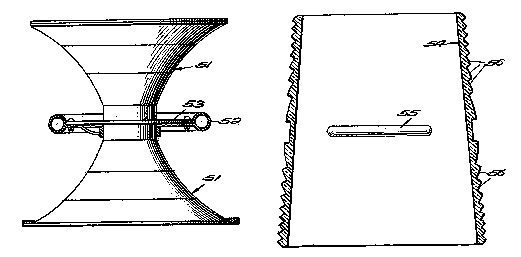

US Pat.
4,200,283 entitled "Strobe Lamp Warning Apparatus" was granted to
this company in 1980. The address is listed as Chicago, IL. This is the last patent
entry for the company and will involve an increased search to determine company
information.
Trademark
No. 1,118,534 was issued to the Safety Products Company for the product name
"Reflectolite". The product line on which the trademark was used was
an electrical warning lamp radiating in substantially all directions an useable
on emergency vehicles. The date of first product use was Jan. 20, 1967. The
date of first use in commerce was August 20, 1968.
This trademark was filed on July 16,
1970 by:
Safety Products Company Corporation Illinois
4806 W. Chicago Ave.
Chicago, IL 60651
The cancellation date for this trademark was Nov. 15, 1985.
The Soo
RR used this strobe extensively. It was a user of the 15360 Gyralites (these
were beacons made by Pyle-National). These Gyralite beacons consisted of a
metal base, a middle colored section and a metal top in which a PAR-46 bulb was
mounted. The strobes were mounted on top of these 15360 Gyralite bases just as
the Tomar strobes were mounted on top the 372 Commander bases (see below).
Advantages to keeping the bases of original units intact could be ease of
mounting and a height advantage.
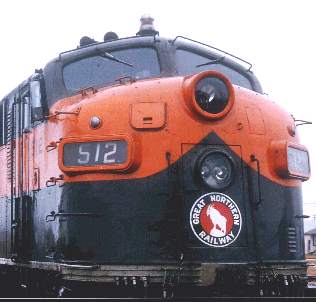
Great Northern
512 E7A (1967) showing the 15360 Gyralite beacon on roof and a 20754 Gyralite
in upper nose. The 20754 was a conversion unit intended to replace the 12 volt
reflector signals (Mars WR-5000-A). This conversion has a vertical bar down the
center (identical in other respects to 20750 Gyralite).
photo by: George Elwood (George Elwood Collection)

crop of above
photo
15360 Gyralite
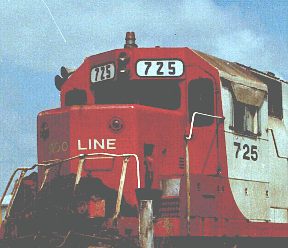
Soo 725
(wrecked) GP35 (1980) - showing Safety Products
strobe mounted on 15360 Gyralite base
photo by: Kameron A. Miller

crop of above
photo
Safety Products strobe
The Soo Line catalog description for the
signal light they widely used in the 1970's and 1980's called for the model 6551-4-74VDC,
which was the Safety Products unit obtained through Unity Railway Supply
Company.
The last listed address of Safety Products
Company is 1010 W. Lake Street, Chicago IL 60607. Their line of signal lights
was distributed by the Unity Railway Supply Company but that relationship is no
longer in existence.
Soo Line Historical & Technical Society
See: Safety Products Model
52 & 6551 Reflectolite Strobes
In 1974 Unity
was listed as:
Unity Railway Supply Co., Inc.
332 S. Michigan Avenue
Chicago, IL 60604
(312) 939-3438
In 1986:
805 Golf Lane
Bensenville, IL 60106
312-595-4562
Listed as "Supplying components for car, locomotive and transit
equipment."
Bill Kaufman
The company is apparently out of
business.
The State of Illinois show the
company being granted recognition as a corporate entity in Oct. 22, 1971 and
dissolved in Mar. 2, 1987.
The following pages (provided be the
Soo Line Historical & Technical Society) were scanned from a
"Unity" brochure:
Page 1
Page 2
Page 3
Page 4
The following photo was provided by:
STAR HEADLIGHT & LANTERN COMPANY, INC.
455 Rochester St.
Avon, NY 14414
360° Strobe:

200BC
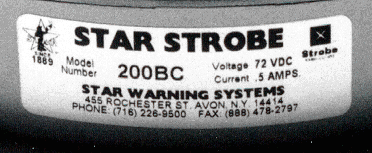
"crop" of above photo
Model 200BC Locomotive Strobe:
Input voltage = 72VDC (operates from 24-125VDC)
Unit draws 0.5A avg. @ 72VDC.
Durable die-cast aluminum housing
Clear outer Lexan dome is easy to clean
Available in Clear, Amber, or Red
Temperature range of -40 to 135 degrees Fahrenheit
Available in single or double flash versions with up to 16 joules per flash
Power supply is located in base of unit
This model is seen on Amtrak, Tri-Rail, and Metra.
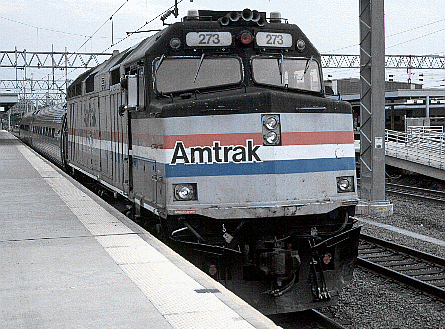
Amtrak
No. 273 F40PH with "typical Amtrak strobe setup" of 2 Star 200BC roof
mounted
strobes and a center strobe between the numberboards consisting of a Trans-Lite
C-1785 housing and Red glass lens.
photo by: Dick Leonhardt
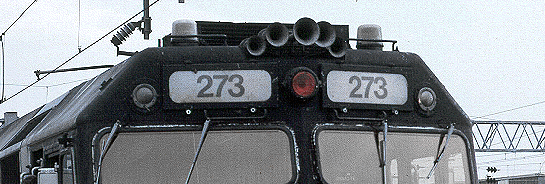
crop of above photo
The following photos and information were
taken from the Tomar Electronics Strobe Light and Application Guide No. 99:
TOMAR ELECTRONICS, INC.
2100 W. Obispo Ave.
Gilbert, AZ 85233
360° Strobes:
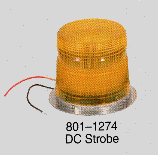
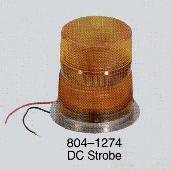
The 801-1274 is 5.25" Tall x 5.5"
Dia.
The 804-1274 is 6.75" Tall x 5.5" Dia.
Both of these models are available in voltages of 12-74VDC and have the Lexan
lens.
Both draw 0.2A avg. @ 74VDC, are rated at 8 Joules per flash, have a flash rate
of 80-95 Flashes per Minute, and have the power supply mounted in the base of
the unit.
Eff. candela:
801-1274 Clear=400/Amber=340/Blue=185/Green=160/Red=80
804-1274 Clear=480/Amber=400/Blue=220/Green=190/Red=95
Tri-Rail uses the Star 200BC strobe on locomotives 810 and 811 (F40PHRs). It uses the 700-1274 Mini Strobe on the rest of its fleet.
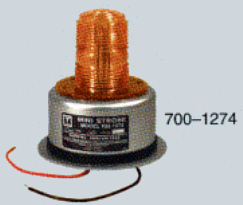
The 700-1274 is 6" Tall x 4.7" Dia.
It is available in voltages of 12-74VDC. The model has a Lexan lens. and draws
0.2A avg. @ 74VDC. it is rated at 8 Joules per flash, has a flash rate of 80-95
Flashes per Minute, and the power supply mounted in the base of the unit.
Eff. candela:
Clear=185/Amber=160/Blue=85/Green=70/Red=40
The taller strobe models were
prefered for roof mounting to enhance visibiltity. The elevation of the strobe
could be further increase by mounting the strobe on top of the base of a former
light unit.
The 804-1274 looks a great deal like what the C&NW put on some of their
units at one time - the right height/dia. ratio, the aluminum band at the
bottom, etc. - and since I know that they used Tomars, I suppose this is either
the same model or the next generation.
Griff Hamilton
Griff
discusses the Tomar strobes being mounted to plates on the Federal Signal
Commander 372 bases:
Yes, the C&NW used the amber strobes, and
before that, they used amber Federal rotating beacons. By around '86 or so, the
gumball machines were not much in evidence. Apparently, the maintenance was
something of a headache, and the strobes - being solid state, so to speak -
took over fast. A few of the Tomar strobes on power I saw being scrapped were
actually mounted on the old cast finned bases of the earlier gumball
machines... the guts would get pulled from the rotating beacon, a circular
metal plate would be bolted on top of the base, and the strobe would be mounted
on that. I suppose it added some height and kept any more holes from being
drilled in the roof. It used to be a lot of fun to get up on the roof of these
units and look at the mods some of them showed evidence of. Traces of different
lights, horns, antennas, etc. - maybe it was also because it was a view you
seldom got up close. Antennas were an odd thing to contemplate... some engines
used the "firecracker," some the "ice skate," and some just
had a little wire one
like a miniature car antenna. They must have all worked.
Griff Hamilton
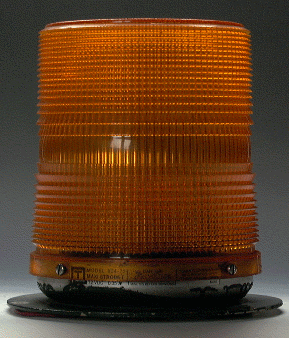
Tomar 804-72
strobe (precursor to 804-1274 model)
off a C&NW GP7 (ex-RI unit)
The GP7 carried this strobe since the 1980s.
photo by: Griff Hamilton
click on image for close-up
Elgin, Joliet & Eastern (EJ&E a/k/a the "J") - use of the Tomar 804-1274 strobe with Red lens
following photos (dated 2000) by:
Neal Stringer - EJE Engineer
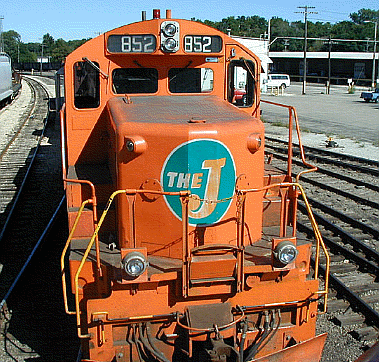
EJE No.852 SD18
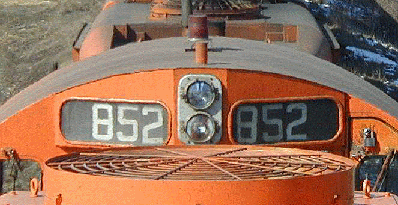
This looks like the
Tomar strobe mounted on a Target Tech 851 strobe base
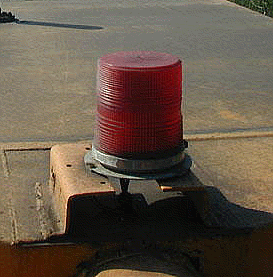
No. 669 SD38-2 with
Tomar strobe mounted on a fabricated base

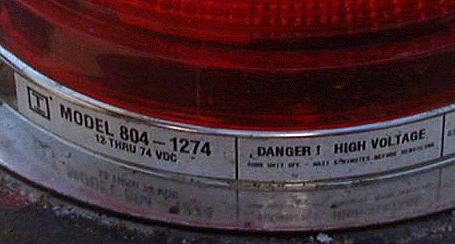
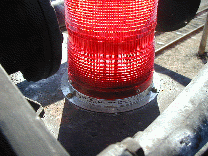
mounting and label detail
click on image for closeup
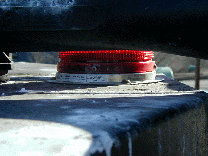
mounting and label detail
click on image
for closeup
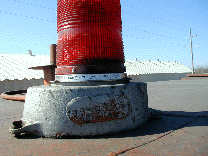
804-1274 mounted on former
15360 Gyralite base
click on image
for closeup
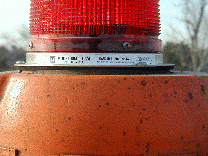
mounting
and label detail of EJ&E No. 659
on 15360 Gyralite base
click on image for closeup
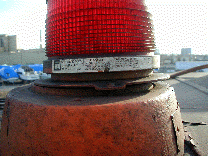
Mounting and label detail of Tomar
804-72
strobe
on EJ&E No. 663
This model is the precursor to the 804-1274.
The strobe is mounted off-center on the base
of the former 15360 Gyralite beacon. The patent
on the label
(US Pat. 4,682,081) refers to the strobe
electronics.
click on image
for closeup
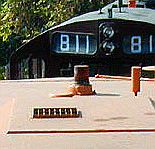
No. 654 SD38 with
Tomar strobe
mounted on a 15360 Gyralite base
The strobes are the
normal engine lights that the J uses to locate their engines in the yard.
We have timetable instructions to turn off the strobes when we enter foreign
yards because they are red.
Neal Stringer - EJ&E Engineer
The following photos and information
were taken from the Target Tech (A Unit Of Federal Signal Corporation) catalog.
TARGET TECH
A Unit Of Federal Signal Corporation
2645 Federal Signal Drive
University Park, IL 60466-3195
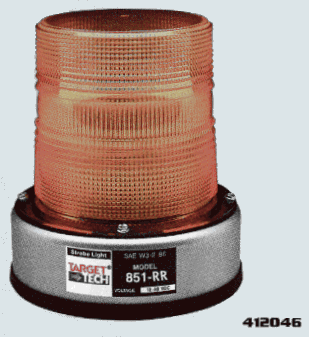
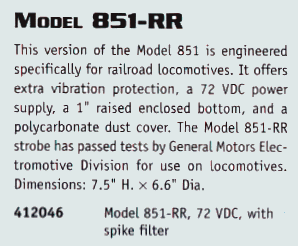
Another photo of this unit (furnished by Federal Signal
Corp.) shows the 851-RR (No. 412046) which uses a 12-48V supply - apparently an
early version of this model.
On
my last trip I had the SOO 6034 leading. At one point, I had a change to get up
on the roof and pass along the following information:
SOO
6034, April 10/2000
Equipped with a orange strobe
Target Tech
Model 851
SAEW 3 2 - 86
Unit of Federal Signal Corp.
72 VDC.
Timothy Organ - Engineer
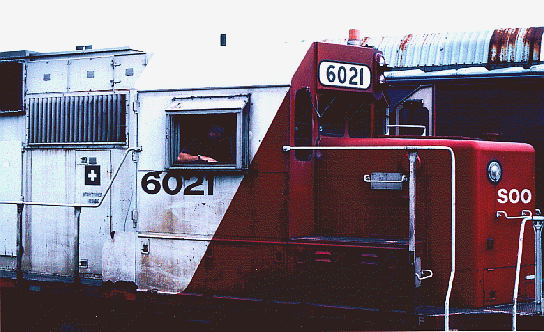
Soo No. 6021 SD60 with
Target Tech (Federal Signal) 851 Strobe
Timothy Organ is the Engineer seen in the window.
photo by: David Stowe
by Timothy Organ
- CP Engineer
1. CN:
I know of only two strobe light applications, a group of CN pass. F units and
engines that are currently employed in the "pitch & catch" remote
control technology ( four red strobe lights on the equipped engine).
2. CP:
Can be broken into two groups - a: applied by the CP, b: acquired by default
when buying used power.
a: CP SD40-2's in the 5600 series that were
in the UP power pool, received UP strobe lights. Units equipped with the remote
control "Pitch & Catch" technology / red strobes, 2 lights
applied per unit. Units equipped for remote control hump service @ Toronto Yard
/ red & white strobes ( more later). Units equipped with engine shut down
warning light (?) single white strobe applied, example CP1270.
b: Units that retained the light package
after being acquired by CP. Former QNS&L retained the orange strobe lights,
former KCS, MILW units retained their Prime beacons etc. Note, this is almost
has to be confirmed on a unit by unit basis.
3. VIA:
The former CN F-units, retained their twin strobe lights until retirement. A
group of LRC 6900's received a signal white strobe light...applied for US
service on Toronto Chicago trains and or winter engine shut down warning light
(?).
4. ONR:
A number of units appear to be equipped with a single orange strobe
light....this is the winter engine shut down light.
Amtrak usage - and others:
by Timothy Organ - CP Engineer
In photos of Amtrak 532 and 531 (an EMD MP15), the locomotives have what appear to be the "BN deck mounted strobe lights" as opposed to regular ditch lights. Note, that based on the two pictures, Amtrak applied these lights to both ends.
These do not appear to be our Q2000's. Nobody here recalls Amtrak as a customer for these and looking at the pictures they appear close but are off on the door latches and arrangement from what we built. We also built none for this type of mounting, but of course the customer could have modified to fit.
Bruce Backus - Quantum Engineering, Inc
As to the Amtrak red light: From what I have read, several railroads for a time used a red mars light, Gyralite, or strobe light to shown when a train was in emergency brake application. Although I have not been able to find a corresponding operation rule to confirm this ( I have read reference to this though), I suspect that the use of this light was to aid in the required flagging rules. This would really be a help in multi track territory. Some RR that used this red light included SP, L&N, C&NW and Santa Fa passenger power, just to name a few. As I mentioned in an a earlier message, I am of the opinion that when Amtrak developed a light program for it's fleet, that the lights were applied to give the fleet the most flexibility when running over the host railroads.
I was once at Toronto Union Station working a GO train and there was a Amtrak train sitting a couple of tracks over. The train must have been in emergency for the red light was flashing and it appeared to me to be a strobe type flash, not a blinking "light".
I have never been inside the Amtrak units, but I have read that the strobe package also as manual controls. In operation, they seem to be connected to the operation of the horn and bell. I am unaware of what manual setting are available.
As a side note, on the SOO engines that I have run, the SD40, SD40-2 and
some of the SD60's have a manual setting for the strobe light. Positions
of on / off. Some were along the SD60 order. This was changed to the
strobe light being connected to the position of the reverser and/or if the
engine moving (Automatic turning on and off).
___________________________________________________